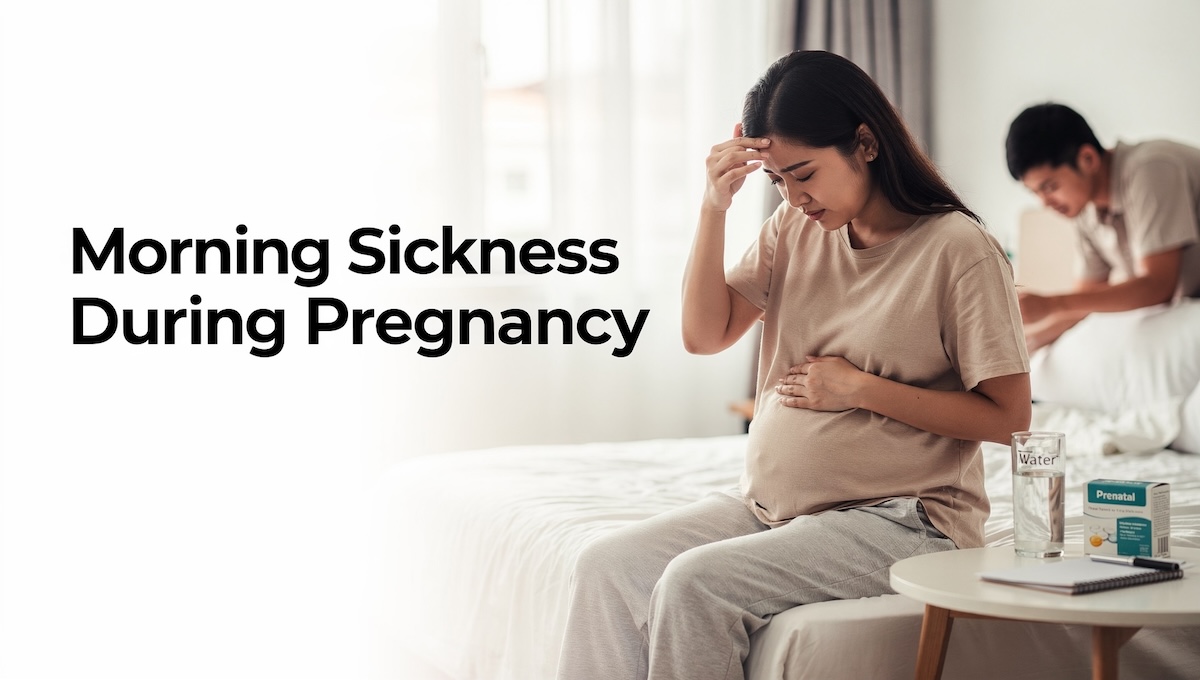As a first-time mother, there are countless decisions about caring for your newborn. A common question parents face is when and how to properly use a pacifier. While some parents swear by them as a soothing tool for their little ones, others worry about potential drawbacks. As with many parenting decisions, there are pros and cons to consider.
This article will explore what you need to know about pacifiers, including their benefits and potential drawbacks, when to introduce them, and how to choose the right one for your baby. By the end of this article, you’ll better understand whether a pacifier is a suitable choice for your family.
Let’s get started!
Is It Good To Give A Baby A Pacifier?
Whether or not it’s good to give a baby a pacifier is a subject of debate among experts and parents alike. Pacifiers can have both benefits and drawbacks, and the decision of whether to use one ultimately depends on various factors, including the individual needs of your baby and your parenting style.
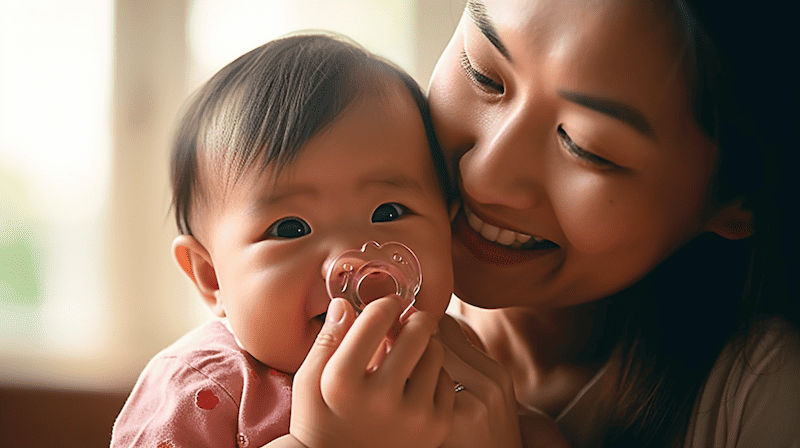
Often, pacifiers can be a soothing tool for babies, helping to calm them down and promote sleep. Also, pacifiers can be helpful during travel or when your baby needs extra comfort.
On the other hand, pacifiers can also have potential drawbacks. For example, babies who overuse pacifiers experience dental problems such as crooked baby teeth or a misaligned bite later in life.
Additionally, some experts have suggested that over-reliance on a pacifier can interfere with their nursing routine. It may lead to nipple confusion and make it more difficult for your baby to develop proper feeding habits.
Ultimately it is up to parents whether or not to allow their baby to use a pacifier and for how long based on individual circumstances and preferences.
When using pacifiers, it’s still best to follow recommended guidelines, like limiting use to sleep times and choosing the right pacifier for your baby’s age and development.
Let’s move forward with a few reasons why doctors, specifically paediatricians, do not recommend using pacifiers for newborns and infants.
Why Do Doctors Not Recommend Pacifiers
Not all doctors will advocate for using pacifiers because of the potential drawbacks associated with prolonged and consistent use. Some of these drawbacks include the following:
- Interference with breastfeeding: There is concern that pacifiers may interfere with breastfeeding by reducing the time infants spend at the breast, potentially leading to decreased milk supply and difficulties with latching.
- Dental problems: Long-term pacifier use can lead to dental problems, including misaligned teeth, overbites, and open bites.
- Increased risk of middle ear infections: Studies have suggested that using pacifiers, particularly in children under six months of age, may increase the risk of middle ear infections.
- Speech and language delays: There is some concern that prolonged pacifier use may lead to speech and language delays, as infants may have fewer opportunities to practice oral communication.
- Skin irritation: Prolonged pacifier use can sometimes lead to skin irritation around the mouth or cheeks.
It’s important to note that not all infants will experience these side effects, and many babies use pacifiers without any adverse effects. However, it’s still advisable to watch for any signs showing pacifier use for your infant causes discomfort or interference in their daily routine.
Despite these concerns, many doctors still recognise the benefits of pacifier use, particularly for soothing fussy babies and reducing the risk of SIDS (sudden infant death syndrome). Sleep-related infant deaths occur when a baby has difficulty maintaining their airway while they sleep. Pacifiers can help keep the airway open, reducing this risk. Pacifiers offer up one way to ensure you little one has a comfortable and safe infant sleeping environment
For parents who choose to use pacifiers, it’s important to take safety precautions and clean them properly. Always inspect for any signs of wear before giving it to your infant, and replace regularly
The American Academy of Pediatrics (AAP) recommends using pacifiers at naptime and bedtime for infants up to one year of age. Also, pacifiers are best used only after breastfeeding habits and properly establishing latching between mother and child.
When using pacifiers to soothe your little one, always clean them between uses and avoid coating them in sweet substances. Coating pacifiers with sweet substances may encourage your infant to ease using the pacifier. Still, it does make it more challenging to wean them off when needed.
Sometimes, your doctor may recommend continued use of pacifiers for severe cases of thumb-sucking or finger-sucking. In these cases, pacifiers offer your infant a more hyenic and safe option.
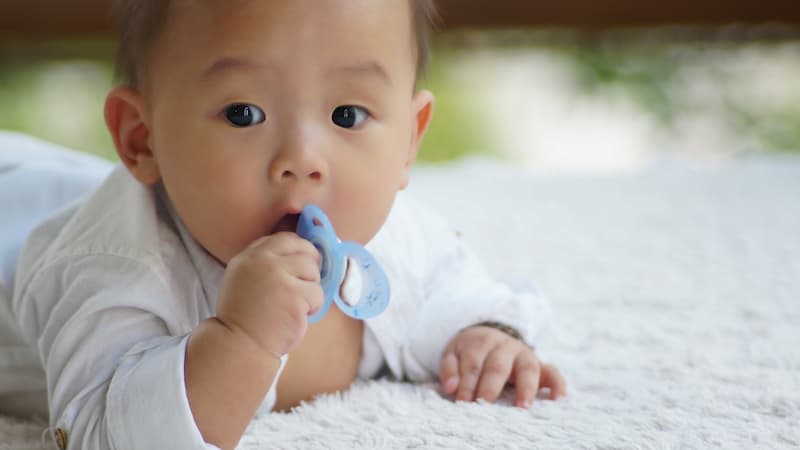
How To Use A Pacifier
Following simple guidelines on using a pacifier prevents the side effects from affecting your infant’s development and health. With that, you can ensure your little one stays healthy and comfortable. Here are some guidelines on how to use a pacifier safely and effectively:
Wait Until Breastfeeding Is Well Established
If you plan to breastfeed your baby, wait until your milk supply is well established. Well-established breastfeeding also includes proper latching that does not bring discomfort to you and results in a good flow of milk from your breast during the baby’s feeding times. Waiting until your baby can breastfeed comfortably before introducing a pacifier prevents any potential interference with breastfeeding.
Choose The Right Size and Shape
Pacifiers come in various sizes and shapes to accommodate different ages and stages of development. Pacifiers that are appropriate for your baby’s age and development ensure it has a comfortable fit in their mouth and cheeks.
Pacifiers that are too large or small could cause the baby’s jaw to strain, whether through an uncomfortable mouth position or puckering to accommodate smaller teats. Additionally, parents should keep in mind the firmness of the teat.
Newborn pacifiers come with softer silicon teats that gently curve to match their delicate gums. Infant teats from 6 months onwards have a firmer teat, ideal for teething babies who start to bite down harder.
Firmer teats prevent your little one’s gums from rubbing together when biting down, ensuring there is less pressure on the gums that could cause injury or irritation.
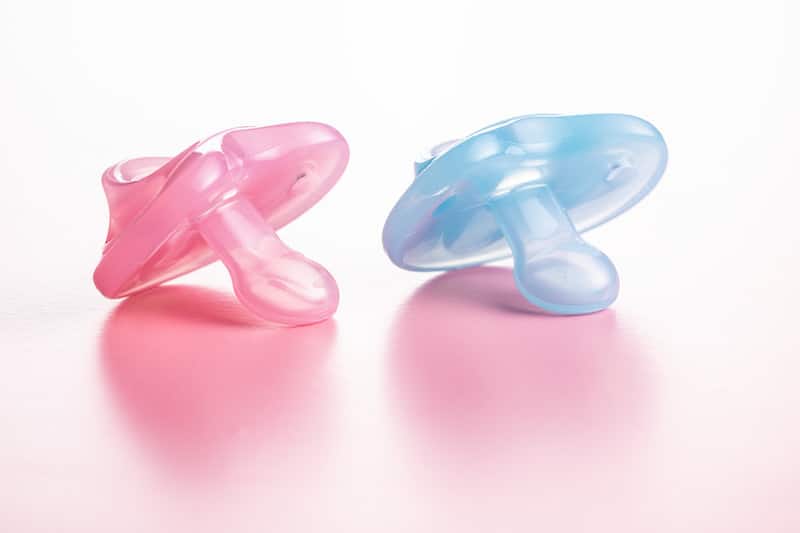
Use the Pacifier For Soothing
Giving your baby a pacifier can be helpful in soothing, particularly during sleep times or in stressful situations. However, try not to rely on the pacifier as a solution for all your baby’s needs. Avoid using it as a substitute for feeding or other forms of comfort.
Limit Pacifier Use
Parents should generally limit the use of pacifiers to nap times and sleep times. However, it is also alright to use them during moments of distress to soothe the baby. Aside from these times, pacifier overuse can lead to dental problems and interfere with breastfeeding.
Clean the Pacifier Regularly
Clean it regularly with soap and water, and replace it as soon as it shows any signs of wear and tear or damage.
Avoid Attaching the Pacifier To A String Or Cord
Attaching a pacifier to a string or cord can create a choking hazard. If you use a pacifier clip or holder, ensure it is designed specifically for pacifiers and is not long enough to pose a risk.
Remember, every baby is unique and may have different preferences regarding pacifier use. Be patient and flexible, and don’t be afraid to experiment with different pacifiers and strategies until you find what works best for your baby.
How Many Hours Can Baby Use Pacifier
When it comes to using pacifiers, there is no one set time limit. However, the American Academy of Pediatrics (AAP) recommends limiting pacifier use to sleep times for infants up to one year.
Additionally, you should only introduce pacifiers to your infant once you have established good breastfeeding habits and latching. Beyond one year of age, most babies can safely and comfortably go without a pacifier during the day.
During sleep times, the AAP recommends that parents offer a pacifier to infants who cannot yet roll over independently, as it can reduce the risk of Sudden Infant Death Syndrome (SIDS). However, you mustn’t force your infant to use a pacifier at any point. It’s okay if your baby doesn’t take to it.
Once your baby is comfortable using pacifiers, you should monitor how frequently they use them and gradually wean them off as they age. The longer your baby uses a pacifier, the greater the risk of dental problems and other potential side effects. By the age of two or three, most children have outgrown the need for a pacifier altogether.
Ultimately, the usage duration is up to individual parents and their infants’ unique needs of sucking on a pacifier. It’s important to discuss any concerns or questions about pacifier use with a healthcare provider.

Should You Remove Pacifier When Baby Is Sleeping
Once a baby is asleep, leaving the pacifier in their mouth is generally safe as long as it is not causing any problems.
However, if your baby repeatedly wakes up because their pacifier falls off their mouth or if the pacifier is causing any discomfort or irritation, you may want to consider removing it.
Additionally, suppose you are trying to wean your baby off pacifiers. In that case, removing it during sleep or nap time may be necessary to encourage them to self-soothe without it.
How To Choose A Pacifier
Choosing the right pacifier for your baby can make a big difference in their comfort and safety. Here are some factors to consider when selecting a pacifier:
- Size and Shape: Pacifiers come in different sizes and shapes to accommodate different ages and stages of development. Choose a pacifier appropriate for your baby’s age that fits comfortably in baby’s mouth. The pacifier should also be easy to hold onto and not too heavy.
- Material: Pacifiers are made from different materials such as silicone, latex or rubber. Silicone pacifiers are hypoallergenic and easy to clean. In contrast, latex and rubber pacifiers are softer and more flexible but may cause allergic reactions in some babies.
- Nipple design: Some pacifiers have bulb-shaped nipples, while others have flatter nipples. You may need to try different nipple designs to see what your baby prefers.
- Brand: Many different brands of pacifiers are on the market, and some babies may prefer one brand over another. It’s a good idea to try a few different brands to see which one works best for your baby.
- Safety features: Look for BPA-free pacifiers with a one-piece design, which reduces the risk of choking. Additionally, some pacifiers have a shield or guard to prevent the pacifier from being swallowed.
Finding the perfect pacifier may take some trial and error, but once you do, it can be a helpful tool for soothing your little one.
Pacifier Brands in Singapore
Here are some popular pacifier brands available in Singapore.
- Philips Avent: This brand offers a range of pacifiers in different sizes, shapes, and designs. Their pacifiers are made of silicone and are BPA-free.
- NUK: NUK pacifiers feature a design that mimics the shape of a mother’s nipple, which can help promote natural sucking behaviour. They also offer pacifiers with orthodontic designs to support healthy oral development.
- Tommee Tippee: Tommee Tippee pacifiers are silicone and have a symmetrical nipple design to promote natural oral development. They also offer pacifiers with glow-in-the-dark features.
- MAM: MAM pacifiers have a unique design with a symmetrical nipple that fits comfortably in the baby’s mouth. They also have an anti-slip surface to help keep the pacifier in place.
When choosing a pacifier brand, consider the factors mentioned in the previous answer, such as size, shape, material, and safety features. In addition, it’s essential to choose a reputable brand tested for safety and quality.
How To Clean A Pacifier
Cleaning your baby’s pacifier regularly is essential to free it from harmful germs and bacteria. Here are some tips on how to clean a pacifier:
- Wash with baby-safe cleaning products for dishes and water: The most common and effective way to clean a pacifier is to wash it with a baby-safe cleaning product for dishes and water. Rinse thoroughly.
- Sterilise: You can also sterilise the pacifier by boiling it in water for 5 minutes. Ensure the pacifier is completely submerged and no air bubbles are trapped inside.
- Use a steriliser: If you have a baby bottle steriliser, you can use it to clean and sterilise pacifiers.
- Use a pacifier wipe: Pacifier wipes are convenient when you’re on the go and don’t have access to soap and water. These wipes are specially designed to clean and disinfect pacifiers.
- Replace pacifiers regularly: Pacifiers can become worn out and damaged over time, making them less effective and more challenging to clean. It’s a good idea to replace your baby’s pacifier every two to four weeks or sooner if it shows signs of wear or damage.
Always check the manufacturer’s instructions for cleaning and safety tips for your specific pacifier.
When To Stop Your Child Using A Pacifier
There is no set age when a child should stop using a pacifier, as every child is different. However, the American Academy of Pediatrics (AAP) recommends weaning your child off the pacifier by age one. This will give your baby enough time to rely on human milk rather than artificial nipples for comfort and nourishment. Here are some signs that your child may be ready to give up the pacifier:
- Age: If your child is past 1 or 2, it may be time to start thinking about weaning them off the pacifier.
- Dependency: If your child constantly uses the pacifier and can’t seem to fall asleep or soothe themselves without it, it may be time to consider weaning.
- Speech development: Prolonged pacifier use can interfere with speech development. If your child has difficulty speaking or forming words, it may be time to wean them off the pacifier.
- Dental problems: If your child is experiencing dental problems such as misalignment of lower teeth or bite issues, it may be time to stop using the pacifier.
When you’re ready to wean your child off the pacifier, gradually reduce their use. You can limit pacifier use to certain times of the day or gradually decrease the time they are allowed to use it. Encourage your child to find other ways to soothe themselves, such as using a stuffed animal or blanket.
Remember to be patient and consistent with the weaning process, as it may take time for your child to adjust. Try different tactics to minimise the disruption to infant sleep. If you have any concerns or questions about pacifier use or weaning, it’s always best to consult a healthcare provider.
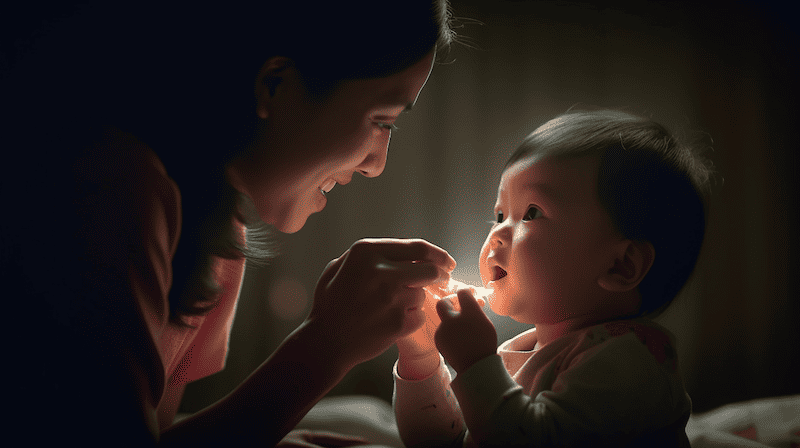
Conclusion
In conclusion, pacifiers can be a helpful tool calm babies, especially newborns, and promote healthy sleep habits. However, using them safely and appropriately is essential, as prolonged use can negatively affect dental health and speech development. Consider size, shape, material, and safety features when choosing a pacifier.
Additionally, weaning your child off the pacifier at an appropriate age is important to prevent any potential negative effects. If you have any concerns or questions about pacifier use, it’s always best to consult with a healthcare provider or other trusted resource.


